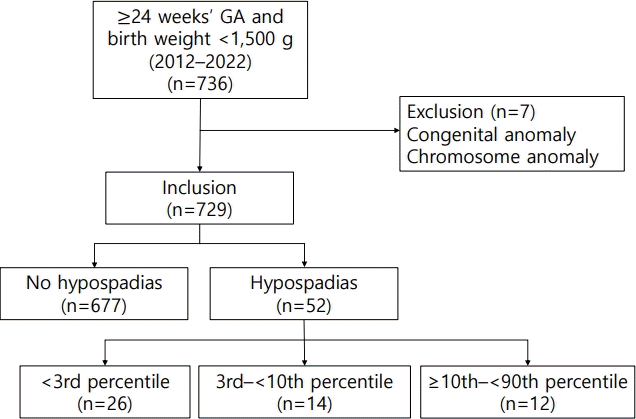1. Yu X, Nassar N, Mastroiacovo P, Canfield M, Groisman B, Bermejo-Sanchez E, et al. Hypospadias prevalence and trends in international birth defect surveillance systems, 1980-2010. Eur Urol. 2019; 76:482–90.

2. Ashina M, Fujioka K, Yoshimoto S, Ioroi T, Iijima K. Incidence of hypospadias in severe small-for-gestational-age infants: a multicenter Asian population study. Pediatr Neonatol. 2020; 61:548–50.

3. Gatti JM, Kirsch AJ, Troyer WA, Perez-Brayfield MR, Smith EA, Scherz HC. Increased incidence of hypospadias in small-forgestational age infants in a neonatal intensive-care unit. BJU Int. 2001; 87:548–50.

4. Chen MJ, Karaviti LP, Roth DR, Schlomer BJ. Birth prevalence of hypospadias and hypospadias risk factors in newborn males in the United States from 1997 to 2012. J Pediatr Urol. 2018; 14:425.

5. Kim SC, Kwon SK, Hong YP. Trends in the incidence of cryptorchidism and hypospadias of registry-based data in Korea: a comparison between industrialized areas of petrochemical estates and a non-industrialized area. Asian J Androl. 2011; 13:715–8.

6. Shin CH, Yang SW. Study on the frequency of receptor insensitivity to androgen using the androgen-receptor binding assay in the genetic male children with abnormalities of sexual differentiation. J Korean Pediatr Soc. 2002; 45:95–102.
7. Yoo JH. Differential diagnosis of hypospadias. J Korean Soc Pediatr Endocrinol. 2006; 11:15–21.
8. Haid B, Tack LJ, Spinoit AF, Weigl C, Steinkellner L, Gernhold C, et al. Being born small for gestational age (SGA) might be associated with a higher reoperation rate in proximal hypospadias. J Pediatr Urol. 2022; 18:609.

9. Nissen KB, Udesen A, Garne E. Hypospadias: prevalence, birthweight and associated major congenital anomalies. Congenit Anom (Kyoto). 2015; 55:37–41.

10. Ghirri P, Scaramuzzo RT, Bertelloni S, Pardi D, Celandroni A, Cocchi G, et al. Prevalence of hypospadias in Italy according to severity, gestational age and birthweight: an epidemiological study. Ital J Pediatr. 2009; 35:18.

11. Toufaily MH, Roberts DJ, Westgate MN, Hunt AT, Holmes LB. Hypospadias, intrauterine growth restriction, and abnormalities of the placenta. Birth Defects Res. 2018; 110:122–7.

12. Hussain N, Chaghtai A, Herndon CD, Herson VC, Rosenkrantz TS, McKenna PH. Hypospadias and early gestation growth restriction in infants. Pediatrics. 2002; 109:473–8.

13. Hwang IT. The present condition of Korean children born small for gestational age. Korean J Pediatr. 2009; 52:137–41.

14. Shin SM, Chang YP, Lee ES, Lee YA, Son DW, Kim MH, et al. Low birth weight, very low birth weight rates and gestational agespecific birth weight distribution of Korean newborn infants. J Korean Med Sci. 2005; 20:182–7.

15. Lim JS, Lim SW, Ahn JH, Song BS, Shim KS, Hwang IT. New Korean reference for birth weight by gestational age and sex: data from the Korean Statistical Information Service (2008-2012). Ann Pediatr Endocrinol Metab. 2014; 19:146–53.

16. Aviram A, Sherman C, Kingdom J, Zaltz A, Barrett J, Melamed N. Defining early vs late fetal growth restriction by placental pathology. Acta Obstet Gynecol Scand. 2019; 98:365–73.

17. Redline RW. Classification of placental lesions. Am J Obstet Gynecol. 2015; 213(4 Suppl):S21–8.

18. Baergen RN. Manual of Benirschke and Kaufmann's pathology of the human placenta. Springer Science & Business Media;2005.
19. Chong JH, Wee CK, Ho SK, Chan DK. Factors associated with hypospadias in Asian newborn babies. J Perinat Med. 2006; 34:497–500.

20. Fujimoto T, Suwa T, Kabe K, Adachi T, Nakabayashi M, Amamiya T. Placental insufficiency in early gestation is associated with hypospadias. J Pediatr Surg. 2008; 43:358–61.

21. Campbell MK, Cartier S, Xie B, Kouniakis G, Huang W, Han V. Determinants of small for gestational age birth at term. Paediatr Perinat Epidemiol. 2012; 26:525–33.

22. Yinon Y, Kingdom JC, Proctor LK, Kelly EN, Salle JL, Wherrett D, et al. Hypospadias in males with intrauterine growth restriction due to placental insufficiency: the placental role in the embryogenesis of male external genitalia. Am J Med Genet A. 2010; 152A:75–83.

23. Hashimoto Y, Kawai M, Nagai S, Matsukura T, Niwa F, Hasegawa T, et al. Fetal growth restriction but not preterm birth is a risk factor for severe hypospadias. Pediatr Int. 2016; 58:573–7.

24. Chen Y, Sun L, Geng H, Lei X, Zhang J. Placental pathology and hypospadias. Pediatr Res. 2017; 81:489–95.

25. Jensen MS, Wilcox AJ, Olsen J, Bonde JP, Thulstrup AM, Ramlau-Hansen CH, et al. Cryptorchidism and hypospadias in a cohort of 934,538 Danish boys: the role of birth weight, gestational age, body dimensions, and fetal growth. Am J Epidemiol. 2012; 175:917–25.

26. Akre O, Boyd HA, Ahlgren M, Wilbrand K, Westergaard T, Hjalgrim H, et al. Maternal and gestational risk factors for hypospadias. Environ Health Perspect. 2008; 116:1071–6.

27. Tannenbaum RL. Risk factors associated with prematurity in patients diagnosed with hypospadias (master’s thesis). University of Cincinnati;2013.
28. van der Horst HJ, de Wall LL. Hypospadias, all there is to know. Eur J Pediatr. 2017; 176:435–41.

29. Chung KM, Lee JY, Han SW. Review of psychosocial and psychosexual adjustment of persons with hypospadias and their parents. Korean J Health Psychol. 2012; 17:1–25.





 PDF
PDF Citation
Citation Print
Print





 XML Download
XML Download